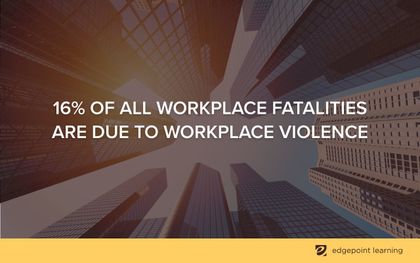How To Prevent Workplace Violence: 7 Steps To Take Right Now
Corey Bleich
🍿 5 min. read
We should not have to have this conversation, but increasingly, workplace violence prevention is something we cannot ignore as business leaders. According to the National Institute for Occupational Safety and Health (NIOSH), in 1996, every week 20 people were murdered and 18,000 more assaulted while on the job. By 2014, that yearly total number was cut in half to about 426 people murdered annually, but 16% of all workplace fatalities are still due to workplace violence. Workplace violence prevention training is crucial to keep your employees and customers safe.
Who is at risk for workplace violence?
There are four major types of workplace violence, including:
- Criminal intent (e.g., robbery by someone with no relationship to the business)
- Customer/client violence
- Worker-on-worker
- Personal relationship (such as domestic violence)
While workplace violence can affect anyone, there are certain risk factors that increase a person’s risk, including gender and occupation.
Gender
Women in particular are vulnerable to domestic violence in the workplace.
They have more than double the rate of on-the-job homicides than men (19% to 8%), with 32% of the homicides committed by a domestic partner.
Occupation
While taxi drivers, healthcare workers, and other social work occupations have some of the highest rates of workplace violence, other sectors of employment are seeing an increase in workplace violence, too. The publication Injury Facts 2016 cites the following workplace violence statistics for 2013:
- Government: 37,110 injuries, 128 deaths
- Education and health services: 22,590 injuries, 35 deaths
- Professional and business services: 4,460 injuries, 65 deaths
For these employees, workplace violence is the third leading cause of death on the job.
In general, the occupations with the highest risk of workplace violence include any that interact with the public, are open after dark, and serve alcohol.

How can workplace violence training help?
There is a serious lack of research on the effectiveness of different types of workplace violence prevention training programs.
However, what research exists shows that preventing workplace violence is possible even with a small amount of effort. In one review of literature regarding workplace violence in healthcare, violence decreased simply by implementing a zero tolerance policy in the emergency room.
Your company’s workplace violence prevention may need to go deeper than that, but it is encouraging that even small changes can yield big results.
How to make your workplace violence prevention programs work
In general, workplace violence is the product of the interaction between three factors.
- The person committing the violence
- The triggering event that motivates the person
- A workplace that is more conducive to allowing violence to happen
Workplace violence prevention training can help mitigate all three factors. Here are seven steps to take to make sure your workplace violent prevention training is effective:
- Analyze your workplace
- Create a supportive environment
- Offer communciation and empathy training
- Establish a clear workplace violence policy
- Commit to a non-violent workplace
- Train employees to recognize warning signs
- Create an action plan, share it with employees, and practice
Let's look at these steps in more detail.
1. Analyze your workplace
A thorough analysis of your workplace is necessary to understand where the bulk of your workplace violence prevention training should focus. Ask yourself these questions to figure out where you are in terms of workplace violence prevention:
- Has there been violence in your workplace before?
- When, what kind, and who was involved?
- How was it handled?
- What systems were put in place afterwards, and were they effective?
- If there have been no violent incidents in your company’s history, what are you doing well?
- Are there gaps in your workplace violence policies? Where?
- How safe is the physical environment? Which doors stay locked? How are employees protected if they leave late at night?
Some companies have never considered how a simple look at existing organizational systems can help target potential risk factors for workplace violence. These questions can help.
2. Create a supportive environment
Every training program starts with developing a relationship with employees. It is important that you and your HR department make employees feel heard and supported at work.
For example, this could help workers who are experiencing domestic violence to be more open with you. Should the domestic partner show up at work, you are then able to respond accordingly. This also means that workers reporting potential violence or verbally threatening remarks should be supported and not face reprisals, regardless of whom they are reporting. Workplace violence policies apply all the way up the corporate ladder and with any client.
3. Offer communication and empathy training
Workplace violence training is often about how to handle a violent episode as it is occurring, but offering workers training in effective, empathic communication can prevent it before it starts.
4. Establish a clear workplace violence policy
How will you handle workplace violence? What supports or disciplinary actions are in place for verbal and nonverbal threats and actions?
If you haven’t answered these questions for your company, start there, then let employees know, with consistent, constant training.
5. Commit to a non-violent workplace
Commitment to a non-violent workplace means regularly allocating resources – money and time – to training workers and preventing workplace violence.
6. Train employees to recognize warning signs
Training employees to be alert to warning signs of potential workplace violence can stop an incident before it starts. Warning signs of potential violence include some or all of the following:
- Excessive use of alcohol or drugs
- Behavioral changes that include poor job performance
- Depression or withdrawal
- Complaints about unfair treatment
- Violation of company policies
- Mood swings and overreaction to criticism or evaluations
- Paranoia
It is important to note that workplace violence can be committed by people who are not mentally ill. There exists a tendency to oversimplify the cause of workplace violence to mental illness, but in most cases that is not true.
7. Create an action plan, share it with employees, and practice
The 1950s had nuclear attack drills; these have been replaced in the 21st century by active shooter simulations and lockdown drills. No one wants to think about the worst-case scenario, much less practice it regularly, but having a plan in place could save lives.
Workplace violence prevention training may not be the most fun training you have ever offered your employees, but it just may be the most important. We can help make it easier. EdgePoint Learning can customize training to your company’s needs (and budget).
Make your workplace a safe place; get in touch today for a complete evaluation of your company’s workplace violence prevention policies and trainings.
Prior to beginning his career in eLearning, Corey Bleich spent over ten years working in crisis intervention and negotiation. During this time, he also provided crisis negotiation and crisis intervention training to law enforcement, emergency response providers, and mental health professionals.
